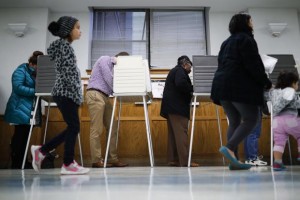Angst over the economy helps Trump flip Great Lakes states

In this Nov. 8, 2016 file photo, voters fill out their ballots at the Nativity School polling place on election day, in Cincinnati. A fractured, discontented electorate handed Donald Trump the presidency, allowing him to breach a region that Democrat Hillary Clinton was banking on in her bid for the presidency. —JOHN MINCHILLO/AP
WASHINGTON — A fractured, discontented electorate handed Donald Trump the presidency, allowing him to breach a region that Democrat Hillary Clinton was banking on in her bid for the presidency.
Key battleground states Pennsylvania, Michigan and Wisconsin had voted for the Democratic candidate in every presidential election for a generation. Ohio, Minnesota and Iowa have been part of winning Democratic maps, as well.
Trump outperformed expectations in all of them, moving most into the Republican column after President Barack Obama twice swept the region.
Exit polls and unofficial returns reflected deep racial, gender, economic and cultural divides nationally and across the Midwest and Great Lakes region, helping drive Trump’s success. His soaring popularity among white voters without a college degree was essential to his capturing the Rust Belt and holding off Clinton in battlegrounds elsewhere, with voters describing themselves as “fed up” and ready for a different, even if unpredictable, direction.
“The forgotten men and women of our country will be forgotten no longer,” Trump said in his acceptance speech, alluding to his economic populist message that helped him shift much of the old industrial territory.
Trump’s support Tuesday skewed older, more male and overwhelmingly white. His supporters said they were deeply dissatisfied with the federal government and eager for change, according to the exit polls conducted by Edison Research for national media outlets.
Nationally, he won almost 7 out of 10 whites without college degrees.
“It’s just shocking that it took a billionaire to connect with the working-class folks that controlled this election,” said Byron Dopkins, a 59-year-old accountant and Trump voter in River Falls, Wisconsin. “It wasn’t the elite, it wasn’t the white collar … it was the working-class people.”
Trump’s surge in working-class regions was evident in places such as Mahoning County, Ohio. Obama won Mahoning, where organized labor still acts as a political force, by a 28-point margin in 2012. On Tuesday, Clinton won it by just 3 percentage points and fell short of Obama’s vote total by more than 20,000.
Obama won nearby Belmont County, in the coal country along the Ohio River, in his first election. It shifted to Romney in 2012, and on Tuesday Trump won almost 70 percent of the vote.
Across Ohio, nearly half of all voters said international trade hurts the country’s jobs situation, and two-thirds of them backed Trump. Two-thirds of the state’s voters said the job situation in Ohio had deteriorated or remained static over the past four years, and three-quarters of them voted for Trump.
John Osborn is a lifelong Democrat who owns a barber shop in Waverly, Ohio. He voted for Barack Obama twice, but the 44-year-old disabled veteran said people in surrounding Pike County have suffered too much.
“We are hurting with industry, we’re hurting with jobs and morale is low. So for me, I had to take the chance” and vote for Trump, he said. “I’m a Trump supporter. I’m not racist. I’m not uneducated. I’m not deplorable. But I’m fed up.”
It was a pattern that repeated across the region.
Clinton did refashion an alliance similar to Obama’s — women, young voters and nonwhites — but it wasn’t large enough.
In Michigan, she lost Flor Penner, a 60-year-old massage therapist who voted for Trump after having twice voting for Obama. Penner lives in the Detroit suburbs of Macomb County, which twice sided with Obama only to see Trump win by almost 12 points.
Penner said Trump will bring needed change to Washington, compared to “something wrong and corrupt” about Clinton. A Filipino immigrant-turned-American citizen, Penner dismissed Trump’s harsh rhetoric on immigration as “just campaigning.”
Clinton’s support was concentrated in large cities, the Northeast and along the West Coast. But even in some key urban areas, Clinton fell short of Obama’s benchmark.
The president won 420,000 votes in Cleveland and surrounding Cuyahoga County in 2012; Clinton won just 383,000.
The urban drop-off was a critical blow to Clinton, as Trump ran up resounding margins in small towns and rural areas, while adding victories in many suburbs.
While Trump clearly struck a chord among white voters, it’s less clear what the electorate that chose him actually wants out of government.
The same group of voters gave Obama a 53 percent approval rating and returned Republican majorities to Congress, where GOP leaders already have clashed with Trump on personality